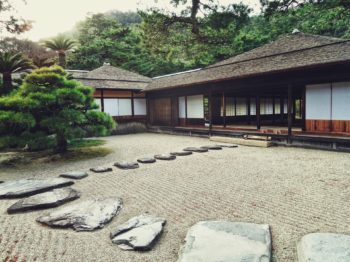Kominka – a future for disappearing villages? Posted by eriko1 on Jul 21, 2021 in Culture, Traditions
Kominka (古民家) – a traditional Japanese old house. A new fad that came about in the pandemic Japan was to escape (逃げる nigeru) from big cities and live in a rural area (田舎 inaka). The COVID-19 pandemic made many people realize that they did not need to live near the big cities and endure a 2-hour/one-way commute in a crowded train every day when remote work was encouraged.
Many rural communities are dying as young people left the communities, leaving only old people in the communities. It is called Genkai Shuraku (限界集落 a village on the verge of disappearing). Over fifty percent of the residents are over 65 years old, and the ability to carry out the communicative function is close to disappearing. As of April 2019, there were 20,372 Genkai Shuraku in Japan.
When the resident passed away, his/her family members living out of the community likely abandoned the old house, farm, mountain, and forest in the rural area. Then Kominka was publicized by foreigners living in Japan and news of their renovations and their lives in the Japanese rural communities was broadcast on TV. Some of them started a guest house (民宿 minshuku) targeting tourists from overseas.
Kominka literally means old houses, and it refers to Japan’s traditional old houses. Meanwhile, “akiya” (空き家) means empty houses, and it does not necessarily mean Japanese traditional old houses. Here I am writing about kominka.
Some younger Japanese families have started to buy kominka and renovate them, getting subsidies (補助金 hojokin) from municipalities with a hope to have a larger house, clean air, and no commute.
There is a very dark side of moving into rural communities with their own traditions, and long family history. Some families moved in only to move out after being explicitly ignored and bullied by the community called Murahachibu (村八分). The hardest adjustment is the human relationship (人間関係 ningen kankei) with people of the community. In the tightly connected community, people know each other for generations, and they know everything about everyone. Newcomers are bombarded with many private questions. Based on such information, or lack of (if newcomers refused to answer), the community may ostracize you.
In rural communities, what is most important is a blood relationship (血縁 ketsuen), followed by a local relationship such as the years you/your ancestor (祖先 sosen) have been living there. So newcomers who have no “blood relationship” or “local relationship” are called yosomono (よそ者outsiders) and may have a hard time being accepted. Then why do foreigners tend to be accepted like in this video below? Shelley Clarke from the US has been living in this kominka for 15 years in a village that has been losing its population. She has a great relationship with her next-door neighbor, who must have helped Shelley to get to know other villagers. When she opened a café, her community members came to celebrate. Shelley does not have any “blood relationship” and she has not lived in the village for generations.
Her love of the village, and her willingness to get to know her neighbor and the village by asking many questions, and the fact that her Japanese is not perfect may be helping her. Also, she lives in the largest house in the village that was owned by the past village head (名主 nanushi), Okamura Family. This relationship with the powerful family in the village must have helped her also. Japanese people who move into kominka tend to have their own ideas, plans, and values. Nature, environment, and dreams of human relationships of their own imagination are important for them, but I am not sure if becoming a member of the community without trying to change the community is in their motives. While Shelley loves the village as it is. Of course, each case is different.
Would you want to own kominka in rural Japan??

Build vocabulary, practice pronunciation, and more with Transparent Language Online. Available anytime, anywhere, on any device.




